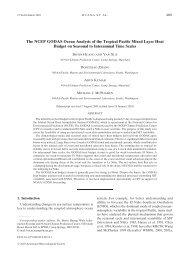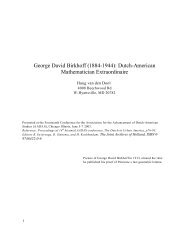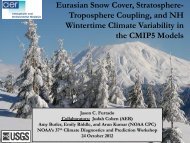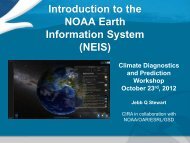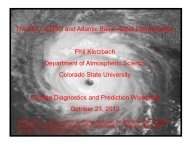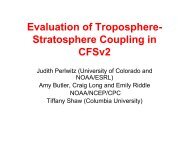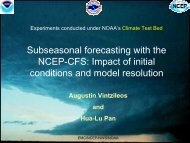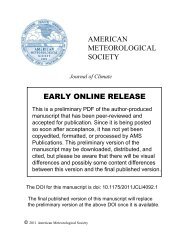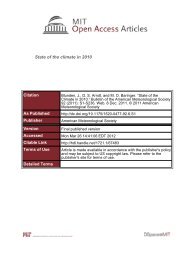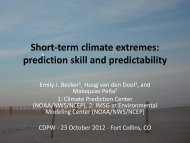MJO - Climate Prediction Center
MJO - Climate Prediction Center
MJO - Climate Prediction Center
Create successful ePaper yourself
Turn your PDF publications into a flip-book with our unique Google optimized e-Paper software.
Authors: Jon Gottschalck, Vernon Kousky, Wayne Higgins, and Michelle L’Heureux<br />
Madden Julian Oscillation (<strong>MJO</strong>)<br />
I. Definition:<br />
The <strong>MJO</strong> is an intraseasonal fluctuation or “wave” occurring in the global tropics. The <strong>MJO</strong> is responsible<br />
for the majority of weather variability in these regions and results in variations in several important<br />
atmospheric and oceanic parameters which include both lower- and upper-level wind speed and direction,<br />
cloudiness, rainfall, sea surface temperature (SST), and ocean surface evaporation. The <strong>MJO</strong> is a naturally<br />
occurring component of our coupled ocean-atmosphere system and the typical length of the <strong>MJO</strong> cycle or<br />
wave is approximately 30-60 days (Madden and Julian, 1971, 1972; Madden and Julian, 1994; Zhang,<br />
2005).<br />
II. Characteristics:<br />
The <strong>MJO</strong> is characterized by eastward propagation of regions of enhanced and suppressed tropical rainfall,<br />
primarily over the Indian and Pacific Oceans. The anomalous rainfall is often first evident over the Indian<br />
Ocean, and remains apparent as it propagates eastward over the very warm waters of the western and<br />
central tropical Pacific. Over the cooler ocean waters of the eastern Pacific, the pattern of tropical rainfall<br />
generally becomes nondescript, but often reappears over the tropical Atlantic and Africa. Along with these<br />
variations in tropical rainfall, there are distinct patterns of lower- and upper-level atmospheric circulation<br />
anomalies in the tropics and subtropics. These features extend around the globe and are not confined to the<br />
eastern hemisphere. Thus, they provide important information regarding the regions of ascending and<br />
descending motion associated with particular phases of the oscillation. Figure 1 illustrates an equatorial<br />
vertical cross section of the <strong>MJO</strong> showing the changes in cloudiness, rainfall, wind speed and direction, and<br />
SST as the <strong>MJO</strong> propagates eastward around the global tropics (Adapted from Madden and Julian, 1971;<br />
1972).<br />
By combining many <strong>MJO</strong> events together into composites, we obtain an idealized representation of the<br />
three dimensional structure of the <strong>MJO</strong> (Figure 2; Rui and Wang, 1990). When convection is active in the<br />
Indian Ocean and Indonesia, anomalous easterlies (westerlies) exit the area of enhanced convection in the<br />
upper levels of the atmosphere and associated with anti-cyclonic gyres along and behind the area of<br />
enhanced convection. Conversely, cyclonic gyres exist behind areas of suppressed convection in both<br />
hemispheres. At low levels, anomalous easterlies (westerlies) are evident ahead (behind) the area of<br />
enhanced convection. The low level gyres are generally weaker than those at upper levels. As the dipole<br />
propagates toward the central Pacific, the lower and upper level circulation anomalies become less<br />
recognizable and coherent but remain an important component in redistributing mass around the global<br />
tropics.<br />
III. Monitoring the <strong>MJO</strong><br />
Due to its slowly evolving nature, accurate prediction of the <strong>MJO</strong> is fundamentally related to our ability to<br />
monitor the feature and to assess its relative position and strength. Dynamical models generally do not<br />
predict the <strong>MJO</strong> well, partly because of the inherent difficulties that still remain regarding the correct<br />
mathematical treatment of tropical convective (rainfall) processes. Meteorologists use a variety of data and<br />
analysis techniques to monitor, study, and predict the formation and evolution of the <strong>MJO</strong>. Of primary<br />
importance is information derived from NOAA’s polar-orbiting and geostationary satellites. Satellitederived<br />
data are used to indicate regions of strong tropical convective activity, and regions in which the<br />
convective activity departs substantially from the long-term mean. These departures from normal are a<br />
fundamental diagnostic tool that is used directly to monitor and predict the <strong>MJO</strong> as it propagates around the<br />
global tropics. A second fundamental data source used to monitor the <strong>MJO</strong> is the global radiosonde<br />
network which provides crucial information regarding the atmospheric winds, temperature, moisture, and<br />
pressure at many levels of the atmosphere. These data are taken twice daily, and assimilated by dynamical<br />
weather prediction models into formats that are highly efficient for climate analysis and numerical weather<br />
prediction. In combination with the satellite-derived rainfall and convection patterns, these observations
provide meteorologists with the capability to routinely monitor and assess the <strong>MJO</strong> and its evolution. They<br />
also allow for a better assessment of the impacts of the <strong>MJO</strong> activity on features such as the wintertime jet<br />
streams, and the large-scale environment within which tropical cyclones develop throughout the Tropics.<br />
There are several diagnostic analysis techniques that allow us to directly monitor the <strong>MJO</strong>. These analyses<br />
are often displayed in time-longitude format so as to reveal the evolution, amplitude and location of the<br />
<strong>MJO</strong>-related features. Typical time-longitude sections are produced for (1) Outgoing Longwave Radiation<br />
(OLR), which is a satellite-derived measure of tropical convection and rainfall, (2) velocity potential, which<br />
is a derived quantity that isolates the divergent component of the wind at upper levels of the atmosphere,<br />
(3) upper- and lower-level wind anomalies and (4) 500-hPa height anomalies to represent the atmospheric<br />
responses in mid-latitudes.<br />
IV. Interannual Variability of the <strong>MJO</strong><br />
There is strong year-to-year variability in <strong>MJO</strong> activity, with periods of strong activity followed by long<br />
periods in which the oscillation is weak or absent (Hendon et al. 1999; Zhang, 2005). There is evidence that<br />
the interannual variability of the <strong>MJO</strong> is partly linked to the ENSO cycle. Strong <strong>MJO</strong> activity is often<br />
observed during weak La Niña years or during ENSO-neutral years, while weak or absent <strong>MJO</strong> activity is<br />
typically associated with strong El Niño episodes. Figure 3 illustrates <strong>MJO</strong> activity for three different<br />
September through June time periods via time longitude plots of velocity potential (a measure of the<br />
divergence of air in the upper atmosphere). The first figure shows regular but generally weak to moderate<br />
<strong>MJO</strong> activity during 1989-1990 while during 1996-1997 there are periods of strong <strong>MJO</strong> episodes but with<br />
less regularity. The final panel shows virtually no <strong>MJO</strong> activity as little eastward propagation is evident<br />
with the most dominant variability being the interannual ENSO (El Nino) signal.<br />
V. Composites of the <strong>MJO</strong> cycle<br />
The <strong>MJO</strong> cycle results in distinct signatures in a number of atmospheric variables throughout the global<br />
tropics depending on its current phase (Knutson and Weickmann, 1987; Rui and Wang, 1990; Kayano and<br />
Kousky, 1999). Typical conditions for eight distinct phases of the <strong>MJO</strong> cycle, as the oscillation propagates<br />
from the Indian Ocean through the Pacific Ocean and into the Western Hemisphere, are illustrated by<br />
figures 4-8 that show 200-hPa velocity potential, OLR, rainfall, 850-hPa wind speed and direction, and sea<br />
level pressure. Composites are given for November through March and for May through September time<br />
periods. The figures depict mean conditions for as many characteristic <strong>MJO</strong> events as are available from<br />
the period 1979-2004. The figures clearly show the eastward propagation of the <strong>MJO</strong>. The 200-hPa<br />
velocity potential composite (Figure 4a) shows that upper-level divergence over the Indian Ocean (top<br />
panel) slowly shifts eastward over the next 30-60 days and re-enters the Indian Ocean to complete a full<br />
cycle (bottom panel). The eastward propagation is evident in all of the figures but especially for the<br />
northern hemisphere winter period (November through March). Figures 5a and 6a illustrate the<br />
disappearance of rainfall in the eastern Pacific Ocean (due to colder ocean water) and areas of enhanced<br />
(suppressed) rainfall over land areas of South America and Africa during various phases of the <strong>MJO</strong> cycle.<br />
Figure 7a shows enhanced easterlies (westerlies) ahead (behind) enhanced rainfall as the <strong>MJO</strong> propagates<br />
through the global tropics.<br />
VI. Impacts associated with the <strong>MJO</strong><br />
Well established, coherent <strong>MJO</strong> activity results in key atmospheric anomalies that can potentially have<br />
wide ranging impacts. Some examples of impacts related to the <strong>MJO</strong> are listed and described below and<br />
illustrated in Figure 9.<br />
1. In areas of upper level divergence (negative velocity potential) enhanced rainfall can occur. Favored<br />
regions over land include Northeast Brazil, Southeast Africa, and Indonesia during boreal winter (Figure<br />
6a) and Central America/Mexico and Southeast Asia during boreal summer (Figure 6b) (Knutson and<br />
Weickmann, 1987; Rui and Wang, 1990; Kayano and Kousky, 1999).
2. The <strong>MJO</strong> can substantially modulate the intensity of monsoon systems around the globe. The Australian<br />
(boreal winter; October-March), Asian (boreal summer; June-September), South American (boreal winter,<br />
October-March) and North American (boreal summer; May-October) monsoons can all be influenced by<br />
the <strong>MJO</strong>. The enhanced rainfall phase of the <strong>MJO</strong> can affect both the timing of monsoon onset and the<br />
intensity of the monsoon. Moreover, the suppressed phase of the <strong>MJO</strong> can prematurely end a monsoon and<br />
also initiate breaks during already existing monsoons.<br />
3. The <strong>MJO</strong> also enhances (suppresses) the intensity and extent of both the mean South Atlantic<br />
Convergence Zone (SACZ; Brazilian coast) and South Pacific Convergence Zone (SPCZ; east of Australia)<br />
(Kousky and Kayano, 1994; Matthews et al. 1996; Carvalho et al. 2004).<br />
4. There is evidence that the <strong>MJO</strong> influences the ENSO cycle. It does not cause El Niño, but can contribute<br />
to the speed of development, and perhaps the overall intensity of El Niño episodes (Kessler and Kleeman,<br />
2000; Zhang and Gottschalck, 2002).<br />
5. The <strong>MJO</strong> is known to modulate tropical cyclone activity in the Indian Ocean, Pacific Ocean, Gulf of<br />
Mexico, and Atlantic Ocean (Maloney and Hartmann, 2000a; Maloney and Hartmann, 2000b; Higgins and<br />
Shi, 2001). For example, although tropical cyclones occur throughout the Northern Hemisphere warm<br />
season (typically May-November) in both the Pacific and the Atlantic basins, in any given year there are<br />
periods of enhanced / suppressed activity within the season. The <strong>MJO</strong> modulates this activity (particularly<br />
for the strongest storms) by providing a large-scale environment that is favorable (unfavorable) for<br />
development. For example, westerly wind anomalies at the surface in and just behind the area of enhanced<br />
convection of the <strong>MJO</strong> may generate cyclonic (anticyclonic) rotation north (south) of the equator<br />
respectively (Figure 2). At the same time, in the upper levels, anticyclonic (cyclonic) rotation develops<br />
along and just behind the area of convection (Figure 2) resulting in a means to reduce vertical wind shear<br />
and increase upper-level divergence – both of which are favorable for tropical cyclone development and<br />
intensification. The strongest tropical cyclones tend to develop when the <strong>MJO</strong> favors enhanced<br />
precipitation. As the <strong>MJO</strong> progresses eastward, the favored region for tropical cyclone activity also shifts<br />
eastward from the Indian Ocean to the Pacific Ocean and eventually to the Atlantic Ocean (Figure 10).<br />
While this relationship appears robust, we caution that the <strong>MJO</strong> is one of many factors that contribute to the<br />
development of tropical cyclones. For example, it is well known that SSTs must be sufficiently warm and<br />
vertical wind shear must be sufficiently weak for tropical disturbances to form and persist.<br />
6. Enhanced tropical rainfall in the western and central Pacific can contribute to extreme rainfall events in<br />
western North America (Higgins et al. 2000). The typical scenario linking the pattern of tropical rainfall<br />
associated with the <strong>MJO</strong> to extreme precipitation events in the Pacific Northwest features a progressive (i.e.<br />
eastward moving) circulation pattern in the tropics and a retrograding (i.e. westward moving) circulation<br />
pattern in the high latitudes of the North Pacific (Figure 11).<br />
VII. References<br />
Carvalho, L, C. Jones, B. Liebmann, 2004: The South Atlantic convergence zone: Intensity, Form,<br />
Persistence, and relationships with intraseasonal to interannual activity and extreme rainfall. J. <strong>Climate</strong>, 17,<br />
88-108.<br />
Hendon, H., C. Zhang, and J. Glick, 1999: Interannual variation of the Madden-Julian Oscillation during<br />
Austral summer. J. <strong>Climate</strong>, 12, 2538-2550.<br />
Higgins, W., J. Schemm, W. Shi, and A. Leetmaa, 2000: Extreme precipitation events in the western<br />
United States related to tropical forcing. J. <strong>Climate</strong>, 13, 793-820.<br />
Higgins, W and W. Shi, 2001: Intercomparison of the principal modes of interannual and intraseasonal<br />
variability of the North American monsoon system. J. <strong>Climate</strong>, 14, 403-417.<br />
Jones, C. and L. Carvalho, 2002: Active and Break phases in the South American Monsoon System, J.<br />
<strong>Climate</strong>, 15, 905-914.
Kayano, M. and V. Kousky, 1999: Intraseasonal (30-60 day) variability in the global tropics: principal<br />
modes and their evolution. Tellus, 51, 373-386.<br />
Kessler, W. and R. Kleeman, 2000: Rectification of the Madden-Julian Oscillation into the ENSO cycle. J.<br />
<strong>Climate</strong>, 13, 3560-3575.<br />
Knutson, T. and K. Weickmann, 1987: 30-60 day atmospheric oscillations: Composite life cycles of<br />
convection and circulation anomalies. Mon. Wea. Rev., 115, 1407-1436.<br />
Kousky, V. and M. Kayano, 1994: Principal modes of outgoing longwave radiation and 250-mb circulation<br />
for the South American sector. J. <strong>Climate</strong>, 1994,1131-1143.<br />
Madden R. and P. Julian, 1971: Detection of a 40-50 day oscillation in the zonal wind in the tropical<br />
Pacific, J. Atmos. Sci., 28, 702-708.<br />
Madden R. and P. Julian, 1972: Description of global-scale circulation cells in the tropics with a 40-50 day<br />
period. J. Atmos. Sci., 29, 1109-1123.<br />
Madden R. and P. Julian, 1994: Observations of the 40-50 day tropical oscillation: A review. Mon. Wea.<br />
Rev., 112-814-837.<br />
Maloney E. and D. Hartmann, 2000a: Modulation of eastern North Pacific hurricanes by the Madden-Julian<br />
Oscillation, J. <strong>Climate</strong>, 13,1451-1460.<br />
Maloney E. and D. Hartmann, 2000b: Modulation of hurricane activity in the gulf of Mexico by the<br />
Madden-Julian Oscillation. Science, 287, 2002-2004.<br />
Matthews, A., B. Hoskins, J. Slingo, and M. Blackburn, 1996: Development of convection along the SPCZ<br />
within a madden-Julian oscillation. Quar. J. Roy. Met. Soc., 122, 1473-1498.<br />
Rui, H. and B. Wang, 1990: Development characteristics and dynamic structure of tropical intraseasonal<br />
convection anomalies, J. Atmos. Sci., 47, 357-379.<br />
Zhang, C. and J. Gottschalck, 2002: SST anomalies of ENSO and the Madden-Julian Oscillation in the<br />
equatorial Pacific. J. <strong>Climate</strong>, 15, 2429-2445.<br />
Zhang, C. 2005: Madden-Julian Oscillation. Reviews of Geophysics, 43, 1-36.<br />
Zhou, J. and K. Lau, 1998: Does a monsoon climate exist over South America J. <strong>Climate</strong>, 11, 1020-1040.
Figure 1: Equatorial vertical cross section of the <strong>MJO</strong> as it propagates from the Indian Ocean to the western<br />
Pacific. Red arrows indicate direction of wind and red (blue) SST labels indicate positive (negative) SST<br />
anomalies respectively. Figure adapted from Madden and Julian, 1971; 1972.
Figure 2: Schematic of the vertical three-dimensional structure of an established <strong>MJO</strong>. Figure adapted from<br />
Rui and Wang (1990). Blue (red) ovals indicate anticyclonic (cyclonic) circulations. Black arrows indicate<br />
wind direction and rising (sinking) motion.
Figure 3: Time longitude plots of 200-hPa velocity potential for the June through September time period<br />
for (a) 1989-1990 (La Nina conditions), (b) 1996-1997 (ENSO neutral conditions), and (c) 1997-1998 (El<br />
Nino conditions).
Figure 4a: Composites of 200-hPa velocity potential (m 2 /s) for eight phases of the <strong>MJO</strong> cycle for the<br />
November through March time period. The anomalies are shown with contours and regions that are<br />
statistically significant (at the 95% confidence level based on a Student-t test) are shaded.
Figure 4b: Same as figure 4a except for the May through September time period.
Figure 5a: Same as figure 4a except for OLR. Units are in Wm -2 .
Figure 5b: Same as figure 5a except for the May through September time period.
Figure 6a: Same as figure 4a except for precipitation. Units are in mm.
Figure 6b: Same as figure 6a except for the May through September time period.
Figure 7a: Same as figure 4a except for 850 mb wind vectors and velocity potential (shading). Units for<br />
velocity potential are m 2 /s.
Figure 7b: Same as figure 7a except for the May through September time period.
Figure 8a: Same as figure 4a except for sea level pressure. Units are in hPa.
Figure 8b: Same as figure 8a except for the May through September time period.
1. Alternating periods of wetter/drier conditions in the tropics<br />
2. ”Pineapple express” heavy rainfall events<br />
3. Modulation of monsoon systems<br />
4. Influence on tropical cyclone development<br />
5. Modulation of ENSO cycle through oceanic Kelvin waves<br />
1. Alternating periods of wetter/drier conditions in the tropics<br />
2. Modulation of monsoon systems<br />
3. Influence on tropical cyclone development<br />
Figure 9: Regions and impacts where <strong>MJO</strong> activity has been shown to influence weather conditions during<br />
the 1-3 week time frame.
Figure 10: Velocity potential composites for different phases of the <strong>MJO</strong> cycle with hurricane/typhoon<br />
origin locations. Green shading indicates upper level divergence and brow shading indicates upper level<br />
convergence. Open circles indicate hurricane/typhoon origin centers.
Figure 11: Schematic of circulation and moisture patterns associated with extreme rainfall events along the<br />
west coast of North America associated with the <strong>MJO</strong>.




